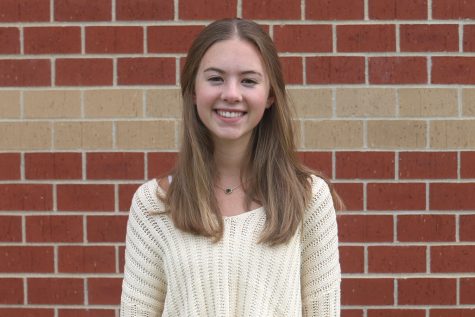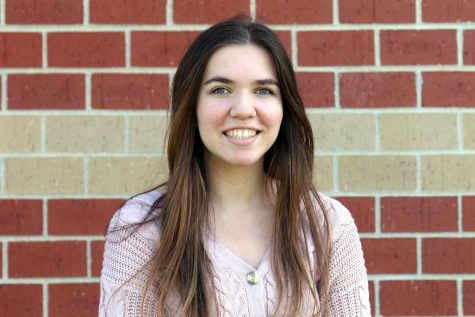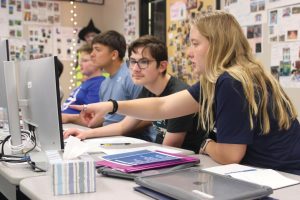Teachers face challenges adjusting to new learning model
The hybrid learning model has forced teachers to change lesson plans and assignments on the fly
English teacher Ashley Agre clicks through a presentation for her freshman English class from the back of the classroom. “Normally I have a quarter outlined at a time,” Agre said. “And [now], not knowing how everything is going to go and how long lessons are going to take, I am only planning a couple of weeks at a time.”
September 22, 2020
Teachers are used to adjusting to new students and changing curriculums. But an entirely different learning model, where they see students in the classroom just one day a week? That’s a new obstacle.
For residential carpentry teacher Arlan Vomhof, who has had to completely rethink his woodworking class and turn a hands-on, project-based course into a virtual experience, changes and challenges continue to arise.
“Even though the curriculum is the same, it’s all new again – how we’re having to change it,” Vomhof said. “Things are changing all the time from day to day.”
After months off from teaching, he had to relearn Canvas, the school’s course management system, and structure everything differently for the new year.
“We got into Canvas [last year] and I was like ‘I want to make sure I know how to do this and be able to use it and I did a really good job last year, but then when you don’t use it for six months, you’re like, ‘I totally forgot how to do it,’” Vomhof said. “And then, I thought I had everything set from last year. And now they want all the teachers to have everything the same, so everything I had last year had to be redone.”
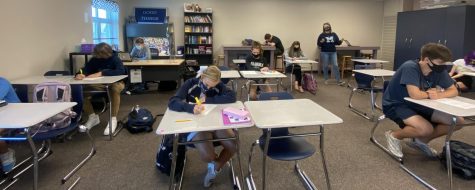
Vomhof isn’t the only teacher who’s had a bumpy transition into the new learning model — for FACS teacher Ellen Gray, the logistical challenges are more difficult than anything she’s faced in two decades as an educator.
“I have been working every night and even a lot during the weekend on lesson planning, grading, and getting everything set up to be taught virtual,” Gray said. “I have already spent more money on my classroom for supplies than I ever have in the past – big monitor so I can see my students when I Zoom, masks, Lysol… In my 19 years of teaching I have never worked so hard the first few weeks of school.”
The year’s new structure has also forced teachers like English teacher Ashley Agre to rethink and rewrite lessons and activities their classes have been doing for years.
“Every activity that I have honed over the years isn’t really going to work anymore,” Agre said. “I am having to teach myself so many new skills to be able to be successful at my job.”
With these changes, some projects and lessons are lost in the crossfire. For the first time ever, Gray chose to make her infamous RealCare Baby project optional, and Vomhof had to remove some of his woodworking class’s hands-on construction — the main draw of the class for some students — from his curriculum.
However, teachers continue to look for the silver lining, even in hectic circumstances.
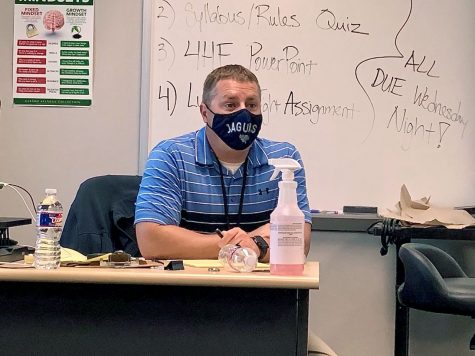
For Agre, this means appreciating smaller class sizes — with students split into A and B groups, each block she teaches at most fifteen students. She believes smaller classes will lead to stronger connections with each student.
“I love the small class sizes! That is by far my favorite thing!” Agre said. “Even though we will only see each other once a week, I think we will be able to build strong relationships.”
For Vomhof, it means being grateful for the opportunity to pick up new skills. He appreciates how the new learning model has made “him more reliant on technology” and forced him to become proficient in it.
Ultimately, though, there’s no question that the changing learning model will continue to create change for teachers in all aspects of their job — and, according to Agre, there’s no telling what challenges might come next.
“We are having to redo every assignment we have ever created. We don’t know how long anything will take at this point,” Agre said. “We are flying by the seat of our pants.”



![English teacher Ashley Agre clicks through a presentation for her freshman English class from the back of the classroom. "Normally I have a quarter outlined at a time," Agre said. "And [now], not knowing how everything is going to go and how long lessons are going to take, I am only planning a couple of weeks at a time."](https://www.mvnews.org/wp-content/uploads/2020/09/TE_AgreTeaching-e1600542986824-900x600.jpg)

